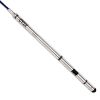HOBO Salt Water Conductivity Logger
Features
- Non-contact sensor provides long life
- Provides easy access to sensor for cleaning and shedding air bubbles
- Requires HOBOware Pro Software and optic base station or waterproof shuttle
- Free ground shipping
- Expedited repair and warranty service
- Lifetime technical support
- More
Overview
The Onset HOBO U24-002-C is a cost-effective data logger for measuring salinity, conductivity and temperature in saltwater environments with relatively small changes in salinity (±5,000 μS/cm) such as saltwater bays, or to detect salinity events such as upwelling, rainstorm, and discharge events. Data from the logger can be used with data from the HOBO U26 Dissolved Oxygen Logger for monitoring percent dissolved oxygen saturation.
Note: When monitoring salinity in waters with more than ±5,000 uS/cm variation, refer to the accuracy shown in Plot C in the product specifications to determine if the accuracy is acceptable for your needs. Monthly field calibration readings are typically required to achieve the best accuracy.
Measurements: Actual Conductivity, Temperature, Specific Conductance at 25C (calculated), Salinity (calculated using PSS-78, the Practical Salinity Scale 1978)
Conductivity Measurement Range (Calibrated Range)
High range: 5000 to 55,000 uS/cm
Low range: 100 to 10,000 uS/cm
Over the range of 5 to 35C (41 to 95F)
Temperature Measurement Range: 5 to 35C (41 to 95F)
Specific Conductance Accuracy (in Calibrated Range using Conductivity Assistant and Calibration Measurements)
Low range: 3% of reading or 50 µS/cm, whichever is greater
High range: 5% of reading, in waters within a range of ±3,000 µS/cm; waters with greater variation can have substantially greater error (see Plot C)
Conductivity Resolution: 2 uS/cm
Temperature Accuracy: 0.1°C (0.2°F) at 25°C (77°F)
Temperature Resolution: 0.01°C (0.02°F)
Conductivity drift: Up to 12% sensor drift per month, exclusive of drift from fouling. Monthly start- and end-point calibration should be used with the HOBOware Conductivity Assistant to achieve the specified Specific Conductance accuracy.
Response time: 1 second to 90% of change (in water)
Operating range: -2 to 36C (28 to 97F) – non-freezing
Memory: 18,500 temperature and conductivity measurements when using one conductivity range; 11,500 sets of measurements when using both conductivity ranges (64 KB total memory)
Sample rate: 1 second to 18 hrs, fixed or multiple-rate sampling with up to 8 user-defined sampling intervals
Clock accuracy: +/- 1 minute per month
Battery life: 3 years (@ 1 min logging)
Maximum depth: 70 m (225')
Weight: 193 gm (6.82 ounces), buoyancy in freshwater: -59.8 gm (-2.11 ounces)
Size: 3.18 cm diameter x 16.5 cm, with 6.3 mm mounting hole (1.25" diameter x 6.5", ¼" hole)
Wetted housing materials: Delrin housing, epoxy, stainless steel retaining ring, polypropylene, Buna rubber O-ring, titanium pentoxide (inert coating over sensor) – all materials are suitable for long-term use in saltwater.
- HOBO U24-002-C Conductivity Data Logger
- Communications window protective cap
In The News
Three Decades of Research at Acton Lake
A multi-disciplinary team at Miami University, Ohio, has been studying the environmental change at Acton Lake for over three decades. Using three different NexSens buoys over this time, the team has an incredible archive of data that is helping build a picture of Acton’s past, present, and future. Until recently, a NexSens CB-50 buoy was used alongside other environmental monitoring at Acton Lake. In May 2025, the Miami team deployed a new XB-200 buoy , future-proofing their ongoing monitoring using real-time buoy systems. Acton Lake, a small hypereutrophic reservoir in southwest Ohio, covers 2.4km² and has a maximum depth of about 8m. The dam was built in 1956, and the lake has a large agricultural watershed.
Read MoreSource Water Monitoring in Albany, New York: Tracing Water Quality throughout Tributaries
Thousands of US cities pull their drinking water from natural source waters like reservoirs, rivers, and streams, making overall watershed health a key consideration for water providers. In Albany, New York, the Albany Department of Water and Water Supply delivers drinking water to over 100,000 residents as well as monitors and manages the larger drinking water supply watershed. Hannah Doherty, Environmental Specialist at the Albany Department of Water and Water Supply , spends her days working with a small team to monitor the drinking supply and the connected water bodies. Doherty explains, “We’re the first to encounter the water that ends up being the drinking water.
Read MoreWildfire Prevention in the Sierra Nevada Region with the Yuba Watershed Institute
Though recent wildfires have sparked new conversations about wildfire management and response, groups like the Yuba Watershed Institute have been monitoring the forests and water resources of the Sierra Nevada region for decades, managing approximately 5,000 acres of land with the Bureau of Land Management (BLM) and about 7,000 acres in private land partnerships. The goal of the Institute is to work with local communities and land agencies to improve watershed and forestry management through informed practices and public outreach. The goals of the Yuba Watershed Institute are three-fold: Improve the ability of fire suppression agencies like the California Department of Forestry and Fire Protection ( CAL FIRE ) and the US Forest Service.
Read More
















